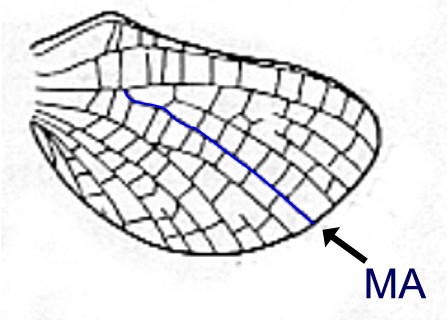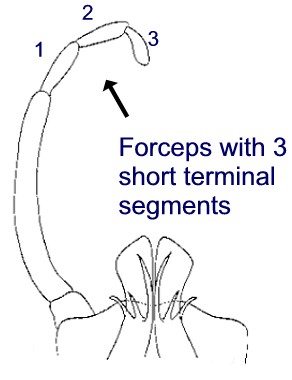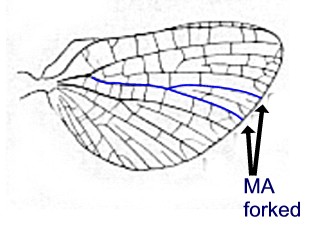 Aquatic Insects of Michigan
Aquatic Insects of Michigan
by Ethan Bright, Museum of Zoology Insect Division and School of Natural Resources and Environment
University of Michigan
- Home
- Species Lists
- Coleoptera
- Diptera
- Ephemeroptera
- Acanthametropodidae
- Ameletidae
- Ametropodidae
- Arthropleidae
- Baetidae
- Baetiscidae
- Behningiidae
- Caenidae
- Ephemerellidae
- Ephemeridae
- Heptageniidae
- Isonychiidae
- Leptohyphidae
- Leptophlebiidae
- Metretopodidae
- Neoephemeridae
- Oligoneuriidae
- Palingeniidae
- Polymitarcyidae
- Potamanthidae
- Pseudironidae
- Siphlonuridae
- Heteroptera
- Hymenoptera
- Lepidoptera
- Megaloptera
- Neuroptera (Sisyridae)
- Odonata
- Orthoptera
- Plecoptera
- Trichoptera
- Other Orders
- Keys/Identification
- Aquatic Insects of Michigan
Heptageniidae, Arthropleidae - Flat-headed Mayflies - Identification
Imagoes (Reproductive adults) (adapted from Edmunds and Waltz 1996, Edmunds et al. 1976)
| 1a | a. Vein MA of hind wing simple, unforked (Figure 1) | Arthropleidae, Arthroplea bipunctata (McDunnough) |
| b. Genital forceps of male with three short terminal segments | ||
| also: Vein Rs of hind wing forming a regular fork | ||
| 1b | a. Vein MA of hind wing forked | 2 |
| b. Genital forceps of male with two short terminal segments | ||
Fig. 1  Fig. 2 Fig. 2  Fig. 3 Fig. 3  |
||
| 2a | a. Eyes large | Males, 3 |
| b. Genital forceps present | ||
| 2b | a. Eyes smaller than male | Females, 12 [note: Anepeorus females cannot be keyed] |
| b. Genital forceps absent | ||
| 3a(2a) | a. Male fore tarsi 0.75x or less the length of the fore tibiae | Anepeorus simplex (Walsh) |
| b. Male genitalia as in figure also: Nymphs from large rivers | ||
| 3b | a. Male fore tarsi longer than fore tibiae | 4 |
| b. Male genitalia not as above | ||
| 4a(3b) | a. Penes as in figure | Raptoheptagenia cruentata (Walsh) |
| b. Longitudinal veins yellowish, crossveins dark | ||
| also: Nymphs from large rivers | ||
| 4b | a. Penes not as above | 5 |
| b. Venation variable | ||
| 5a(4b) | a. Stigmatic area of fore wing with from 2 to many anastomoses of crossveins | Rhithrogena Eaton |
| b. Basal segment of fore tarsi one-third or less the length of segment 2 | ||
| c. Fore femora usually with a dark longitudinal streak near the middle | ||
| 5b | a. Stigmatic area of fore wing with or without anastomosed crossveins | 6 |
| b. If crossveins anastomosed, basal segment of fore tarsi 0.5x or more longer than segment 2 | ||
| c. Fore femora usually without a dark longitudinal streak | ||
| 6a(5b) | Basal segment of fore tarsi equal or slightly longer than segment 2 | Epeorus (Iron) Eaton |
| also: Penes with well-developed median spines (titillators); stigmatic crossveins of fore wings not anastomosed | ||
| 6b | Basal segment of fore tarsi < 0.8x the length segment 2 | 7 |
| also: Penes lobes fused medially at least in basal half; length of basal segment of fore tarsi < 0.66x (usually 0.5x) that of segment 2 | ||
| 7a(6b) | a. Wings with 2-3 crossveins below bullae between veins R1 and R2 connected by, or nearly connected by, dark pigmentation, rarely only a dark spot | Stenacron Jenson |
| b. Basal crossveins between R1 and R2 dark margined | ||
| 7b | a. Wings may have crossveins below bullae clouded, but never as above | 8 |
| b. Crossveins between R1 and R2 rarely dark margined | ||
| 8a(7b) | a. Penes distinctly L-shaped, median titillators usually well-developed but without subdiscal sclerotized ridge 2 | Stenonema Traver |
| b. Basal segment of fore tarsi usually 0.33-0.66x length of segment | ||
| 8b | a. Penes not distinctly L-shaped as above, median titillators moderately to well-developed, with basal-lateral subdiscal sclerotized ridge | 9 |
| b. Basal segment of fore tarsi 0.2-0.5x length of segment 2 | ||
| 9a(8b) | a. Eyes contiguous on vertex or separated by less than the diameter of the median ocellus | Nixe Flowers |
| b. penes with minute dorsolateral spines, discal spines present or absent | ||
| also: Basal costal veins weak | ||
| 9b | a. Eyes separated at least by the width of a lateral ocellus | 10 |
| b. Dorsolateral spines of penes present or absent | ||
| 10a(9b) | Eyes separated by little more than the diameter of a lateral ocellus | Heptagenia Walsh |
| also: Penes with large dorsolateral spines, discal spines absent | ||
| 10b | Eyes separated at vertex by 3-5x the diameter of the median ocellus | 11 |
| 11a(10b) | a. Eyes separated at vertex by approximately the width of one compound eye | Leucrocuta Flowers |
| b. Median titillators of male genitalia slender | ||
| c. Penes with large dorolateral spines, discal spines present | ||
| d. Crossveins behind costa and subcosta usually margined in brown | ||
| 11b | a. Eyes separated by width of 4-5x the width of the median ocellus | Macdunnoa persimplex (McDunnough) |
| b. Median titillators of male genitalia slender | ||
| c. Penes with large dorsolateral spines, dical spines preseent | ||
| d. Crossveins behind costa and subcosta often tan to black | ||
| also: rare throughtout its range | ||
| 12a(2b) | Subanal plate with a moderate to deep V-shaped posteromedian emargination | Epeorus (Iron) Eaton |
| also: Posterior margin of head only with a shallow emargination; basal costal crossveins of wing weakly developed, appearing detached anteriorly; stigmatic crossveins of wing not anastomosed; wing length < 12 mm | ||
| 12b | Subanal plate either broadly rounded or with only a slight posteromedian emargination | 13 |
| 13a(12b) | a. Stigmatic area of fore wing with two to many anastomosed crossveins | Rhithrogena Eaton |
| b. Femora of most species with dark longitudinal streak near middle | ||
| 13b | a. Stigmatic area of fore wing usually without crossveins anastomosed | 14 |
| b. Femora usually without a dark longtiduinal streak near the middle | ||
| 14a(13b) | a. Wings with 2-3 crossveins below bullae between veins R1 and R2 connected or nearly connected by dark pigmentation, rarely only a dark spot | Stenacron Jenson |
| b. Basal crossveins between R1 and R2 dark margined | ||
| 14b | a. Wings may have crossveins below bullae clouded, but never as above | Stenonema Traver, Heptagenia Walsh, Nixe Flowers, Leucrocuta Flowers, Macdunnoa persimplex (McDunnough) [no key available] |
| b. Basal crossveins between R1 and R2 rarely margined | ||
Mature nymphs (adapted from Edmunds and Waltz 1996, Edmunds et al. 1976)
| 1a | a.
All gills ventral |
Raptoheptagenia cruentata (Walsh) |
| b. Gill lamellae slender c. Gill filaments radiating out from a central plate | ||
| also: From large rivers | ||
| 1b | a. Gills on at least Ab4-6 lateral | 2 |
| b. Gill lamellae usually broad c. Gill filaments variable | ||
| 2a(1b) | With only two well-developed caudal filaments, the terminal filament vestigial or absent | 3 |
| 2b | With three well-developed caudal filaments | 4 |
| 3a | a. Ab1-2 gills inserted ventrally, Ab3 gill inserted ventrally or ventrolaterally | Anepeorus simplex (Walsh) |
| b. Tarsal claws with a single tooth and no denticles | ||
| also: Mouthparts adapted for predation; head and each thoracic segment with paired dorsal tubercles; abdomen with single dorsal tubercles medially; from large rivers | ||
| 3b | a. Gills inserted laterally on Ab2-6, which may extend ventrally on Ab1 and Ab7 | Epeorus (Iron) Eaton |
| b.Tarsal claws without a tooth, but with three or more subapical denticles | ||
| 4a(2b) | Second segment of maxillary palpi longer than head is broad, in dorsal view conspicuous at the side or behind head | Arthropleidae, Arthroplea bipunctata (McDunnough) |
| also: Pools, swamps and fens, small slow streams | ||
| 4b | Second segment of maxillary palpi not greatly enlarged, inconspicuous in dorsal view | 5 |
| 5a(4b) | Gills on Ab1 and Ab7 enlarged and meet (or almost meet) beneath the abdomen to form a ventral disk | Rhithrogena Eaton |
| 5b | Gills on Ab1 and Ab7 do not meet beneath the abdomen and usually are smaller than the intermediate pairs | 6 |
| 6a(5b) | Gill on Ab7 minute, no longer than the posterolateral projections of that segment also: rare throughtout its range | Macdunnoa persimplex (McDunnough) |
| 6b | Gills on Ab7 much larger than above | 7 |
| 7a(6b) | Gills on Ab7 reduced to slender filaments, their trachea absent or with few or no lateral branches | 8 |
| 7b | Gills on Ab7 similar to preceding pairs but smaller, trachea with lateral branches | 9 |
| also: Gill lamellae on Ab1 2/3x long as those on Ab2; fibrilliform portion of Ab1 gill usually subequal to, or shorter than, the lamella; labrum never more narrow at apex than at base | ||
| 8a(7a) | a. Gills on Ab1-6 with apex pointed | Stenacron Jenson |
| b. Maxillae with stout spines on crown of galea-lacinia | ||
| 8b | a. Gills on Ab1-6 with apex rounded | Stenonema femoratum (Say) |
| b. Maxillae with setae or plumose hairs on crown of galea-lacinia | ||
| 8c | a. Gills on Ab1-6 with apex rounded or truncate | Maccaffertium Bednarik |
| b. Maxillae with setae or plumose hairs on crown of galea-lacinia | ||
| 9a(7b) | a. Ab7 gill with fibrilliform portion present and with numerous fibrils | Heptagenia Walsh |
| b. Claws without denticles, but with one basal tooth | ||
| 9b | a. Ab7 gill without a fibrilliform portion | 10 |
| b. Claws with denticles | ||
| 10a(9b) | Head large, wider than pronotum, and with many dark spots near the anterior margin | Leucrocuta Flowers |
| 10b | Head not as wide as the pronotum, and without numerous spots near the anterior margin | Nixe Flowers |
References
-
Edmunds GF, Waltz RD. 1996. Ephemeroptera, pp. 126-163 in Merritt RW, Cummins KW (editors), An Introduction to the Aquatic Insects of North America, 3rd Edition. Kendall/Hunt Publishing Company: Dubuque, Iowa.
Edmunds GF, Jensen SL, Berner L. 1976. The mayflies of North and Central America. University of Minnesota Press: Minneapolis, Minnesota. x + 330 p.
Page created: November 10, 2003; Last edited: November 06, 2013 (EB)